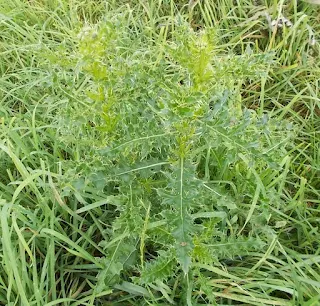The worst of the bunch is called Canadian Thistle, even though it originated in Eurasia. Like many invasive aliens, it can spread by both seeds and through roots called rhizomes or stolons. It can form large colonies. Its posture is highly adaptable, it can squats down low when mowed and can grow 4 feet tall when competing for sunlight. It has few insect enemies and no animal that will graze or browse it. And its thorns punish bare feet.
 |
| Before spraying. Notice how the color and texture blends in with the grass in the pasture |
 |
| Bull thistle before spraying |
 |
| Bull thistle 4 days after spraying. Notice the twisted shape. This is typical of a spray that contains 2-4-d. It gives a good visual to identify the individuals that you missed on the first pass. |
Eaton Rapids Joe's notes on spraying weeds:
-Choose a time of year when the target weeds are vulnerable.-Look at the weather report. Ideally you will have 24 hours of contact time before it rains.
-Spraying in the morning when there is dew on the leaves is good because the leaves are already 'wet' and your spray will flow out on the leaves and then dry.
Prepare the water.
-Add 1 teaspoon (volume) of Swimming Pool pH Reducer per two gallons of spray water. Do this before adding any other chemical. The pH Reducer sequesters the calcium, iron and magnesium in hard water so it won't interact with the chemicals you paid high dollars for. Low pH also helps the chemicals overcome the protective coatings on the weed leaves. Add clean water. Slosh around until dissolved. A couple of packages of Koolaid Lemonaid (citric acid) can be used in a pinch.
-Add a goodly squirt of liquid dish detergent. This should be 2 oz to 4 oz for a 2 gallon sprayer. Actual amount is not critical. The detergent allows the spray to 'wet' the surface of the leaves more efficiently.
-Use 2-4-d Amine formulation. There is an Ester formulation that is 'hotter' but it has the downside of evaporating and the vapor killing plants (like tomatoes and grapes) that you did not spray. Another objection is that the Ester formulation stinks. Follow the label recommendations for amount of concentrate to add per gallon. Be advised that you are on your own if you choose to go 'off-label' and double the amount of concentrate if your target plants are hard-to-kill species like Ground Ivy
-Add glyphosate (Round-up is a common trade name) if you are spot spraying. That is, if you are targeting individual plants or if you want total kill off. Again, follow the label for amount of concentrate to use.
2-4-d and glyphosate combine well. 2-4-d is a plant growth regulator. It triggers un-regulated cell division (almost like cancer in animals) which chokes off the vessels that transport sap and nutrients. The un-regulated growth also depletes the plant's energy reserves. The glyphosate interfers with photosynthesis so the plant cannot restore the depleted energy reserves. The 2-4-d makes the plant's stems twist like a worm in a blow torch. It is gratifying to see if you have ever stepped on a thistle or had to comb burdock (Public Enemy #3) out of a German Shepherd's coat.
-Make sure the nozzle is clear of debris.
-Tweak the nozzle so the stream is fairly narrow. Remember, we are spot spraying.
-Do not over-pump the sprayer. The goal is to put the spray on the target, not to atomize the spray. Big droplets are less likely to blow. Big droplets give better wet-out on the target because they are less likely to bounce off.
-The biggest barrier to getting the chemical into the plant is overcoming the barrier on the surface of the leaves. Spraying after mowing is like main-lining heroin into the veins. It is very effective but is more work.

No comments:
Post a Comment
Readers who are willing to comment make this a better blog. Civil dialog is a valuable thing.